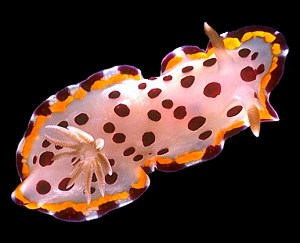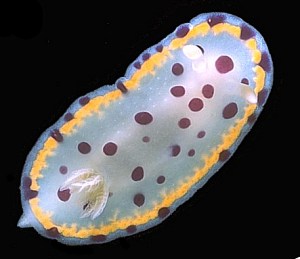

Chromodoris tumulifera
Collingwood, 1881.
Order: NUDIBRANCHIA
Suborder: DORIDINA
Family: Chromodorididae
DISTRIBUTION
Tropical Western Pacific.
PHOTO
UPPER: Hinchinbrook Is, North Queensland, October 1983.
LOWER: Juvenile showing mantle glands around inside edge of yellow border. Darwin, Northern Territory, June 1987
PHOTOS: Bill Rudman.
I previously thought that C. tumulifera and C. bimaensis were distinct species, mainly on the grounds that the spots of C. bimaensis are distinctly purple, (red in C. tumulifera ), and are often open in the centre to form irregular rings (Rudman, 1983). However further specimens I have seen from Australia and New Caledonia of red spotted specimens show a range of colour patterns; some specimens having spots outside the submarginal orange border and others not; some specimens with solid red spots and others with a mixture of spots and irregular rings as in `typical' C. bimaensis. The only difference then is the purple versus red coloration. As they show a range from a very light to a very dark red, it would seem better to consider C. tumulifera and C. bimaensis as one species.
In juvenile animals branches of the dendritic mantle glands are clearly visible along the inside edge of the submarginal yellow border. As the animals grow larger the mantle becomes more opaque white and the glands are obscured. A close-up picture of the glands can be seen in an answer on the Defensive Glands page.
Note added 12 Feb, 2002: Gosliner (1994) described C. kitae from northern Madagascar as a new species, mainly because the orange submarginal line was interrupted by both white and red-purple spots, while in C. tumulifera it is only interrupted by purple spots. Another difference is that in C. kitae there are white spots on the gills and rhinophores. I suspect the differences fall within the range of variation of C. tumulifera.
References:
• Gosliner, T.M. (1994) New species of Chromodoris and Noumea (Nudibranchia: Chromodorididae) from the western Indian Ocean and southern Africa. Proceedings of the California Academy of Sciences 48(12): 239-252. (8 figs)
• Rudman, W.B. (1983a) The Chromodorididae (Opisthobranchia: Mollusca) of the Indo-West Pacific: Chromodoris splendida, C. aspersa and Hypselodoris placida colour groups. Zoological Journal of the Linnean Society, 78: 105-173.
• Rudman, W.B. (1991) Purpose in Pattern: the evolution of colour in chromodorid nudibranchs. Journal of Molluscan Studies, 57, (T.E. Thompson Memorial Issue): 5-21.
Rudman, W.B., 1999 (May 21) Chromodoris tumulifera Collingwood, 1881.. [In] Sea Slug Forum. Australian Museum, Sydney. Available from http://www.seaslugforum.net/factsheet/chrotumu
Related messages
-
Chromodoris tumulifera from northern Gulf of Thailand
From: Vie Panyarachun, April 22, 2010 -
Chromodoris tumulifera from Singapore
From: Lim han Peng, February 25, 2005 -
Chromodoris woodwardae & C. tumulifera
From: Nishina Masayoshi, March 7, 2003 -
Chromodoris tumulifera from Japan
From: Nishina Masayoshi, September 12, 2002 -
Chromodoris tumulifera from New Caledonia
From: Bill Rudman, February 15, 2002 -
Chromodoris 'bimaensis' from Fiji
From: Bill Rudman, February 15, 2002 -
Chromodoris tumulifera from Hong Kong
From: Bill Rudman & Brian Darvell, January 27, 2002 -
Chromodoris tumulifera from Sulawesi
From: Lindsay Warren , June 3, 2001 -
Chromodoris tumulifera
From: Bill Rudman, May 21, 1999
